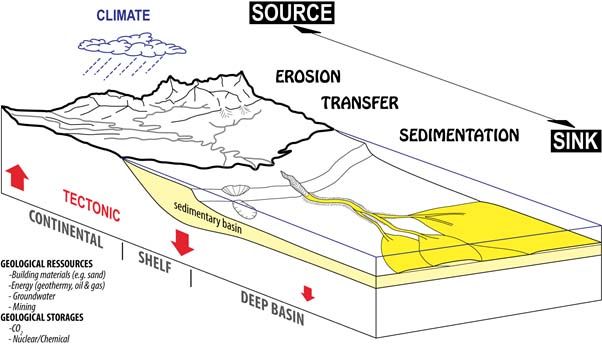S2S-FUTURE
At geological timescales, the Earth’s surface is now seen as the interface between the Solid Earth (lithosphere, mantle, core) and the Fluid Earth (hydrosphere, atmosphere, biosphere). Its shape results from interior deformations and erosive processes associated with climate changes. In response to deformation, the Earth’s surface is formed of zones of lithospheric uplifts with high reliefs such as mountain belts dominated by erosion and sediment production: the “Sources”, which transfer sediment to low relief areas of lithospheric subsidence, which form sedimentary basins dominated by deposition: the “Sinks” (see the figure).

The scientific objectives of S2S-FUTURE are to understand, quantify and model the sediment routing system from the sediment production (source) to the sediment deposition (sink); its tectonic and climatic controls; and to establish generic rules for a full understanding of signals propagation in S2S systems for building predictive models of sediment location and characteristics. These studies of S2S systems require interdisciplinary approaches combining geomorphology, sedimentology and stratigraphy, geochemistry, tectonic and paleoclimatology coupling observations, quantifications and process modelling.
The main ambitions of S2S-FUTURE are:
- to model the response of the S2S system to tectonic and climatic forcing for a better prediction of the physical characteristics of the sediments of the sink of major interest for societal and industrial applications;
- to train 15 doctoral students (Early Stage Researches – ESR) at highest level in term of state-of-the-art concepts, techniques, multidisciplinary knowledge, ability to address complex systems, and to provide them with specific soft skills (project management, economic, entrepreneurial) necessary for employment in both academic and non-academic sectors;
- to promote, develop and increase the visibility of European research through the creation of a network and development of a perennial Summer School, specialized web portals and other legacies beyond the ITN project.



